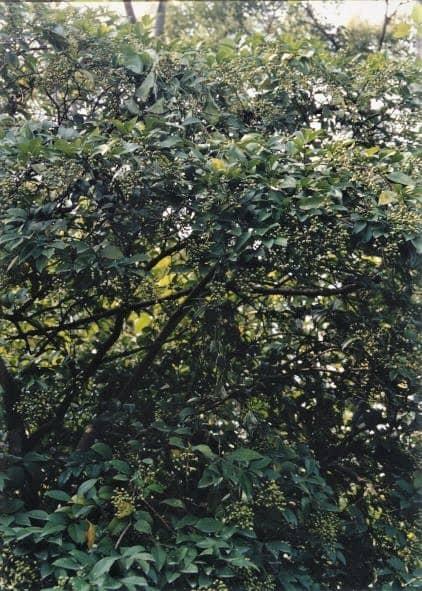Fructus Ligustri Lucidi
- Name
- Origin
- Where Does It Grow?
- Nature and Flavor
- Identified Active Components / Major Chemical Constituents
- Drug Actions in TCM

- Traditional Uses in TCM
- Pharmacological Actions
- Toxicology
- Administration and Dosage
- Adverse Effect, Side Effects and Cautions
- References
Name
Latin Name: Fructus Ligustri Lucidi
Common Name: Glossy privet fruit
Scientific Name: Ligustrum lucidum Ait.
Chinese Name: 女貞子
Pinyin Name: nu zhen zi
Origin
The ripe fruit of Ligustrum lucidum Ait., an evergreen arbor tree of the Oleaceae family.1
Where Does It Grow?
Glossy privet fruit is growing everywhere in China, and is mainly distributed in the Zhejiang, Jiangsu, Hunan, Sichuan and Fujian provinces of China.1
Nature and Flavor
Glossy privet fruit is cool in nature, sweet and bitter in flavor, and mainly manifests its therapeutic actions in the liver and kidney meridians.1
Identified Active Components / Major Chemical Constituents
Glossy privet fruit contains nuzhenide, olenropein, -hydroxy-beta-phenylethyl-beta-dglucoside, oleanolic acid, manitol, betulin, lupeol, salidroside, oleic acid, linolenic acid, palmitic acid and other fatty acids. 5,6,7The skin of the fruit contains oleanolic, acetyl oleanolic acid and ursolic acids. The seed contains 14.9% lipids and the lipids contains 19.5% palmitic and stearic acids as well as 80.5% oleic and linolenic acids. Its flower bud contains manitol, rutin, luteolin-7-beta-D-glucoside, apigenin-7-beta-D-glucoside, apigenin-7-beta-D-glucoside and quercetin.7,8
The leaf contains oleanolic glycoside, 4-hydroxy-beta-phenylethyl-beta-d glucoside and ligstroside. The volatile organic content of Fructus Ligustri Lucidi contains large amounts of ester, alcohol, ether, thioketone and hydrocarbon and small amounts of amine and aldehyde.6
Drug Actions in TCM
Glossy privet fruit invigorates liver yin and kidney yin, enriches blood and benefits the eyes.1Traditional Uses in TCM
Pharmacological Actions
Toxicology
Administration and Dosage
A decoction is typically made with 10-15g of glossy privet fruit and three to four cups of boiling water until the volume is reduced by half.1 A decoction is usually taken orally and split into two doses but this dose may taken all at once or escalated depending on the person's condition and recommendation by the Chinese medicine practitioner.
Adverse Effect, Side Effects and Cautions
Glossy privet fruit may lead to symptoms of abdominal pain and diarrhea if not used in conditions with Yin deficiency.3
References
- Lui Daiquan, ed. Chinese Medicine. Shanghai Scientific and Technical Publishers, Jun-2000.
- Li Jiashi, ed. Chinese Medicine Identification. Shanghai Scientific and Technical Publishers, Feb-2000.
- Wu Yiluo. Bencao Congxin (New Compilation of Materia Medica), 1757AD.
- Li Shizhen, Bencao Gangmu (Compendium of Materia Medica), 1578AD.
- Pharmaceutical Institute of the Academy of Medical Science of China, ed. Chinese Medicine Record, People’s Medical Publishing House.
- Li Kaihui, et al. Study of the chemical ingredients of volatile oils in Fructus Ligustri Lucidi. Proprietary Chinese Medicine 1992; 12(12):32.
- Wang Yusheng, ed. Chinese Medicine Pharmacology and Application. People’s Medical Publishing House 1983; p130-135.
- Li Junxian. Study of the chemical ingredients in Fructus Ligustri Lucidi. Pharmaceutical Journal of China 1990; 15(3):40.
- Dai Yue, et al. Effects of Fructus Ligustri Lucidi decoction on the mice immune system. Journal of Pharmacy School of China 1987; 18(4):301.
- Yu Lugang , et al. Effects of Fructus Ligustri Lucidi polysaccharides extract on the mice immune functions. Pharmaceutical Journal of China. 1992; 27(1):26.
- Ren Jun, et al. Effects of oleanolic acid on on prostaglandins and cAMP. The China Pharmaceutica Journal 1992;27(1): 179-181.
- Zhao Ying, et al. Effects of Fructus Ligustri Lucidi on the lipid peroxide content in mice brain, liver and the effects on liver SOD activity. China Pharmaceutical Journal 1990; (6):47.
- Dai Peixing, et al. Experimental study of active ingredients of Fructus Ligustri Lucidi that increases white blood cell counts. Proprietary Chinese Medicine Studies 1982; (1):42.
- Wang Yunmo, et al. Study progress of anti-ageing Chinese Medicine. Progress of Pharmacology. People’s Medical Publishing House 1986; 56-67.
- Chinese People’s Liberation Army 163 Hospital Central Laboratory , et al. Pharmacological experimental report of total acetic acid extract Fructus Ligustri Lucidi leaf. Newsletter of Chinese Herbal Medicine 1979; 10(8):21.
- Ma Xuehui, et al. Study of effects of oleanolic acid on preventing and treating experimental liver damage. Pharmaceutical Journal 1982; 17(2):93.
- Han Dewu, et al. Study of effects of oleanolic acid on preventing and treating experimental cirrhosis. Pharmaceutical Journal 1981; 22(3):57.
- Ji Chunxuan, et al. Study of effects of oleanolic acid on preventing and treating experimental liver damage. Medical and Pharmaceutical Journal of Shanxi 1980; 9(6):5.
- Quoted in “Wang BX ed. Modern Pharmacological studies on Chinese Medicine. Tianjin Scientific Technology Publishing, 1999: 1347-1352.”


